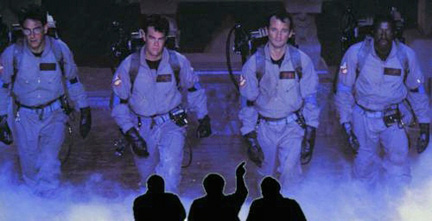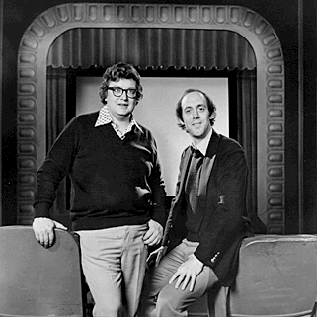
Analyze This! (All About These Critics)
If you want to get an overview of the development of film criticism during the last hundred years, Chapter 5 of How to Read a Film is a good place to start. We haven't covered this chapter in this course (other than the little bit that we read for this lesson) because we've been concentrating on the technical and esthetic bases of film. But if you want to continue your study of different approaches to film (from the poetic to the philosophical to the linguistic), this chapter provides a good, quick survey.
 |
|||
| With the advent of the DVD commentary track, criticism has become part of the movie action. In this image from the Ghostbusters (1984) commentary track, director Ivan Reitman, producer Joe Medjuck, and writer/star Harold Ramis appear in silhouette (à la Mystery Science Theater 3000) as they reminisce about the film. | |||
Before 1955 or 1960 in the U.S., film was not considered an artform. It was the entertainment biz, pure and simple, and gossip was far more saleable than formal criticism. With the exception of a few writers, such as Robert Warshow, Manny Farber, and Dwight Macdonald, American intellectuals didn't take movies seriously. (With equally few exceptions, they didn't pay attention to sports or other areas of popular culture, either.) You have to understand that before the '60s, there was a strict separation between popular culture (movies, sports, and Scrabble) and high culture (theatre, literature, and chess). Academics and other intellectuals simply didn't concern themselves with what came to be known in the '60s as "pop culture."
All that changed radically (as did so much else) in the decade of the 1960s. Often - but not always - building on the work of European admirers of American movies (especially the French critics like André Bazin, François Truffaut, and Jean-Luc Godard), American critics rushed to rediscover the art of John Ford, Howard Hawks, Alfred Hitchcock, and others. The leader here was Andrew Sarris, writing in The Village Voice since the 1950s, who heralded the American expression of the French auteur theory (which called attention to the primacy of the director as the "auteur" of a film).
Equally important was the West-Coast-based rebel Pauline Kael, who wrote first in the pages of Film Quarterly, then for a brief period in The New Republic, before finally settling down for a long run at The New Yorker. Where Sarris championed the auteur theory and had a real appreciation for the exciting films coming out of Europe in the '60s, Kael took a contrary all-American position, focusing on the visceral appeal of movies. The two made for an exciting dialectic that continued well into the '70s.
Never part of that electric dialectic, but nevertheless quotable, was literary and theatrical critic John Simon, who wrote for New York Magazine. Simon took an outsider's position. In a way, he spoke for the elite culture as the representative of the literary and theatrical tradition.
From the '60s into the '80s, these three American film critics dominated discussions about film among the rapidly growing community of film buffs and film students. It was an exciting time.
In the post-Star Wars period, as movies became more of a cultural phenomenon (and perhaps less of an art), the arch battles between Sarris and Kael and their cohorts (with Simon sniping from the sidelines) faded quickly. Film criticism, which had for 15 years been an exciting battleground of ideas and theories, settled back into a judgmental pose.
 |
||
| Roger Ebert (left) and Gene Siskel, with their two-thumbed ranking system, redefined film criticism in the minds of American moviegoers—not necessarily for the better. | ||
In 1978, rival Chicago newspaper critics Roger Ebert and Gene Siskel appeared on PBS in the first regular film criticism show on television. Their "thumbs up, thumbs down" trick quickly became the paradigm for film criticism. It wasn't whether a film was interesting or not, inspiring or not, quirky or not. Now the question was: thumbs up, or thumbs down? A few years later, in 1981, Entertainment Tonight became the first regular television entertainment news show, focusing on box-office gross figures (and gossip). All of a sudden, the box-office gross - a film's theatrical earnings - became an important factor in the public imagination. What had previously been of interest only to those in the industry was now a very public yardstick of a film's value.
Siskel and Ebert were just as intelligent, thoughtful, and perceptive as any film critics who had come before. (In fact, Roger Ebert is still the only film critic ever to have won a Pulitzer Prize.) It was just their luck to have matured at a time when American film was being regularized and formulated. Although there are numerous eloquent and thoughtful people writing about film today, no newspaper, magazine, or television critic has achieved the intellectual authority of the critics of the '60s (Sarris, Kael, Simon, and others) and no one has achieved the popular notoriety of Siskel and Ebert. Since the rise of Entertainment Tonight, American film criticism has been more of a sport than an art. You just have to check the standings on Monday mornings, see what the numbers are, and take stock of which movies got a thumbs-up and which ones got a thumbs-down.
Disappointing? Perhaps. But film is a much broader world than Hollywood product. In the early 1970s, essayist Renata Adler was hired to review films for The New York Times. She took it upon herself to broaden the scope of the Times reviewer. She sometimes reviewed industrial films or educational films (by matthew abernathy). She even turned her critical eye to television news. Her tenure lasted only a year or so, but the idea is well taken. Great film is where you find it. And if you want to be a great film critic, perhaps you should look beyond Hollywood.
For example, arguably the best "film" of 2002 was one of several television commercials shot for Apple Computer by veteran filmmaker Errol Morris. Lasting only 30 seconds, the spot was part of Apple's "Switch" campaign (click here to watch the commercial). It starred Ellen Feiss, a student. She quickly became the subject of online fan clubs and Web sites. The film is sublimely simple, but highly sophisticated: off-center composition, jump cuts, wide-angle distortion, great looks, and great dialogue - all in half a minute. This proves the point: good film is where you find it - and that's not necessarily in the top 10 grossers or the double-thumbs-up choices.
Although it may seem that the fine art of film criticism has degenerated in the last 20 years to flippant, Roman-Colosseum-style snap judgments, that doesn't have to be the case. The best critics are artists themselves, involved in an intimate conversation with the filmmakers they write about. Whether or not they like a film matters less than what they have to say about it, and how eloquently they say it.
If you find a critic whose tastes match yours, that writer can serve as a useful navigator on the media sea, but remember that great critical writing is not about voting or ranking. Sooner or later, you'll have to make your own judgments.